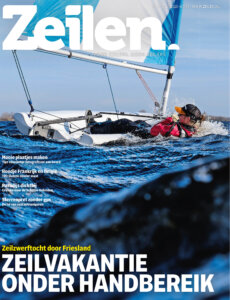This article was created in collaboration with International Paint:

Are you thinking of switching to a biocide-free foul-release system but are unsure of the best approach? This was Wouter and Walda Lower’s dilemma. After taking some time to consider, they selected International’s system. It’s straightforward to apply and similar to ordinary antifouling, but it doesn’t contain a biocide.
The WSV de Zeevang yacht club in Edam was a hive of activity. The dress code was workwear – overalls, gloves and face masks – as numerous boats, chocked up on the hard-standing, were being treated to a new layer of anti-fouling. A deadline was approaching fast. A large crane was scheduled to arrive in a week’s time to launch them back into the water – the Friendship 28 Freya, owned by Wouter and Walda Lower, would be among them.
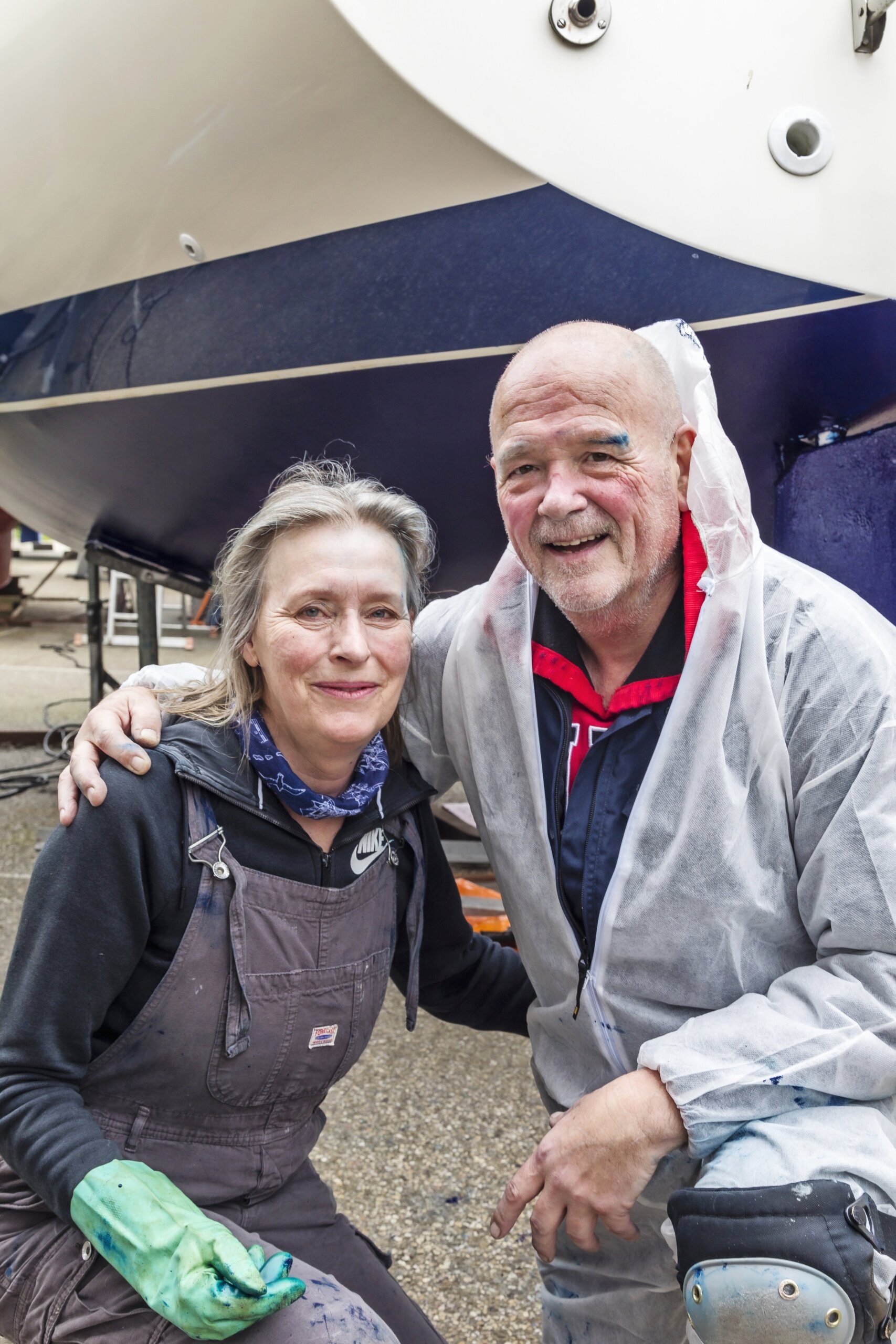
“For several years, we’ve been applying the VC17M antifouling solution from International to protect the hull below the waterline,” Wouter and Walda said. In search of an alternative solution, the couple consulted with watersports retailer Dekker in Zaandam. “There appeared to be two possible options in our case. These were to strip the underwater hull completely, right down to the gelcoat and then rebuild with a paint system of our choice, or to opt for a new system from International Paint, called B-Free Explore.
The key benefit of this paint system is that it eliminates the need to remove the old layers of paint. The new system is simply applied over the existing antifouling, such as our VC17M.” As the name suggests, B-Free Explore is completely biocide-free. This was exactly what Wouter and Walda were looking for. They enrolled onto the workshop on the B-Free Explore system and started work on Freya.


Preparations
We met with Wouter and Walda in Edam during the final week before all the vessels were due to be launched at WSV de Zeevang. The primary obstacle was to wait for four consecutive days without rain and a temperature that was consistently above 10 degrees Celsius. That proved to be a challenge but eventually the weather improved, although there was still a southwesterly wind blowing through the rigging.
Prior to the application of the new underwater paint system, it’s essential that the hull is thoroughly prepared. Walda and Wouter began by cleaning off any growth on the hull and removing old layers of fouling. The team was equipped with proper protective clothing and facemasks were worn at all times. Subsequently, the entire underwater section of hull was sanded with 180-grit paper. “We are fortunate to have a dust extraction system, which allows us to dry-sand,” commented Wouter. In the absence of this, it’s imperative to wet-sand only since the antifoul dust produced is highly toxic. Following two days of intensive preparation work, the hull is in excellent condition – sanded smooth and providing the perfect substrate for the first layer, the B-Free Conversion Coat.
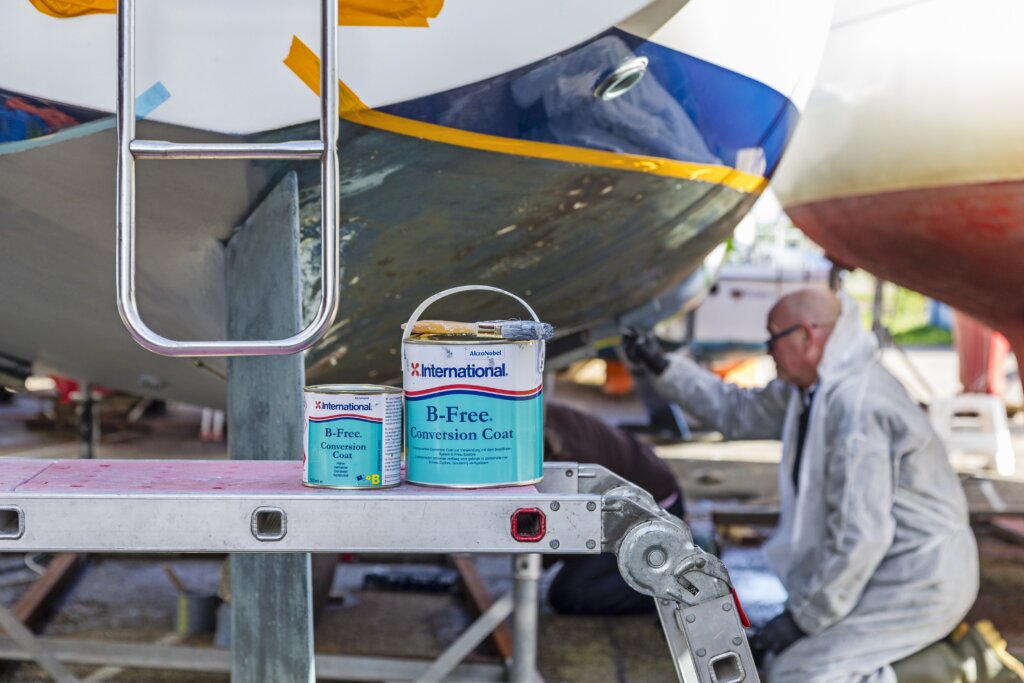
The B-Free Explore System comprises three steps:
B-Free Conversion Coat
This is the first layer of the B-Free Explore system. This two-component paint seals off the old antifouling and provides good adhesion for the next two coats. The primary benefit is that this product can be applied over existing conventional antifouling products. The Conversion Coat allows for a biocide-free system to be implemented without the need to remove the existing antifouling.
B-Free Tiecoat
The system’s second layer of paint is an adhesion primer, formulated with silicone technology. This primer contains silicone, which ensures optimal adhesion between the first layer (Conversion Coat) and the third layer (B-Free Explore). It should be noted that B-Free Tiecoat is also compatible with other primer systems from International Yacht Paint, including the epoxy primer Gelshield 200 for polyester, or Interprotect for steel, aluminium and wood.
B-Free Explore
The third and final step comprises the foul-release paint, B-Free Explore. The foul-release paint should be applied in two layers. This silicone-based underwater coating has foul-release properties and is biocide-free, making it much less damaging to underwater ecosystems. Furthermore, this foul-release paint has a longer lifespan than conventional biocide-containing antifouling paints, while requiring less maintenance during use.
Building up layers
The B-Free Conversion Coat is a two-component product, with a mixing ratio of 4:1. Once mixed, the paint must be left to react for ten minutes before application. It’s important to note that the ambient temperature must be above 10 degrees Celsius and the paint should not be applied in damp conditions. For application, a short pile or foam roller should be used. The first coat was applied to the hull by Wouter and Walda in less than an hour. Don’t forget to remove the masking tape from the waterline as soon as the new paint has been applied in order to prevent it from flaking at the edges. With work complete for the day, the rollers were packed away, ready to apply the tiecoat the following day.
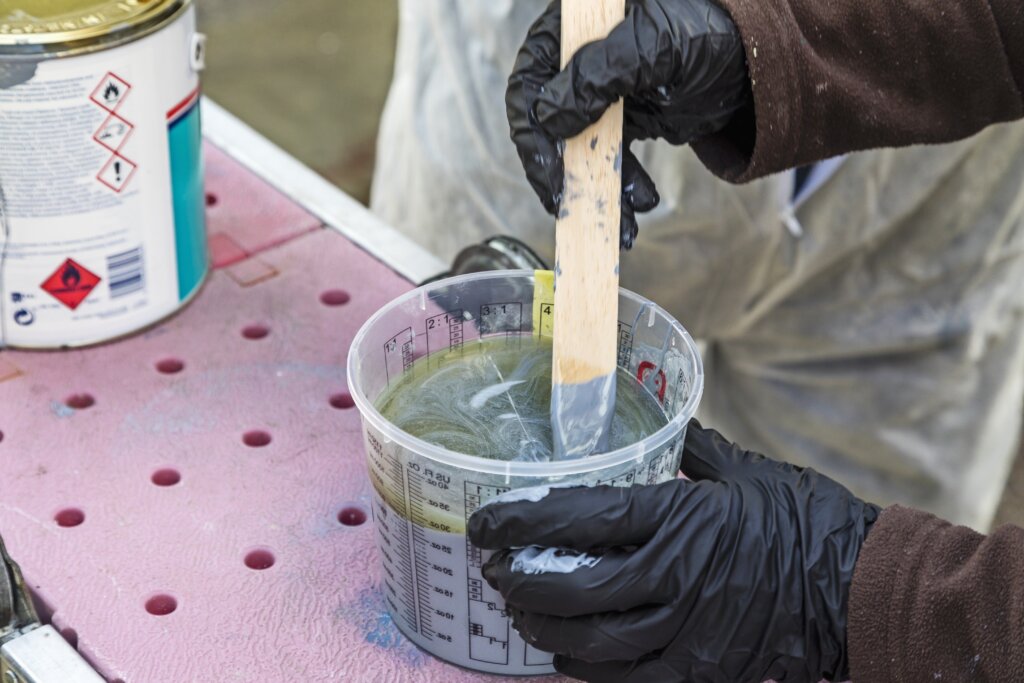

The next day, before applying the second layer, Walter taped up the waterline with masking tape again. The B-Free Tiecoat is light pink in colour. This useful feature makes it easy to identify any areas which haven’t been fully covered. As the tiecoat contains silicone, it should be applied carefully to avoid contaminating any other areas of the hull, or neighboring boats. For this reason, all materials used, such as paint trays, rollers, gloves and masking tape, should be placed in a separate waste bag. Once the surface has dried for a further 24 hours, the final step is to apply two coats of B-Free Explore. B-Free Explore is a one-component, silicone-based paint. One of the reasons Wouter and Walda chose this system is that the paint is biocide-free, however, it’s important to exercise caution when applying it to avoid inadvertently spreading the silicone onto other areas of the yacht or surrounding vessels.

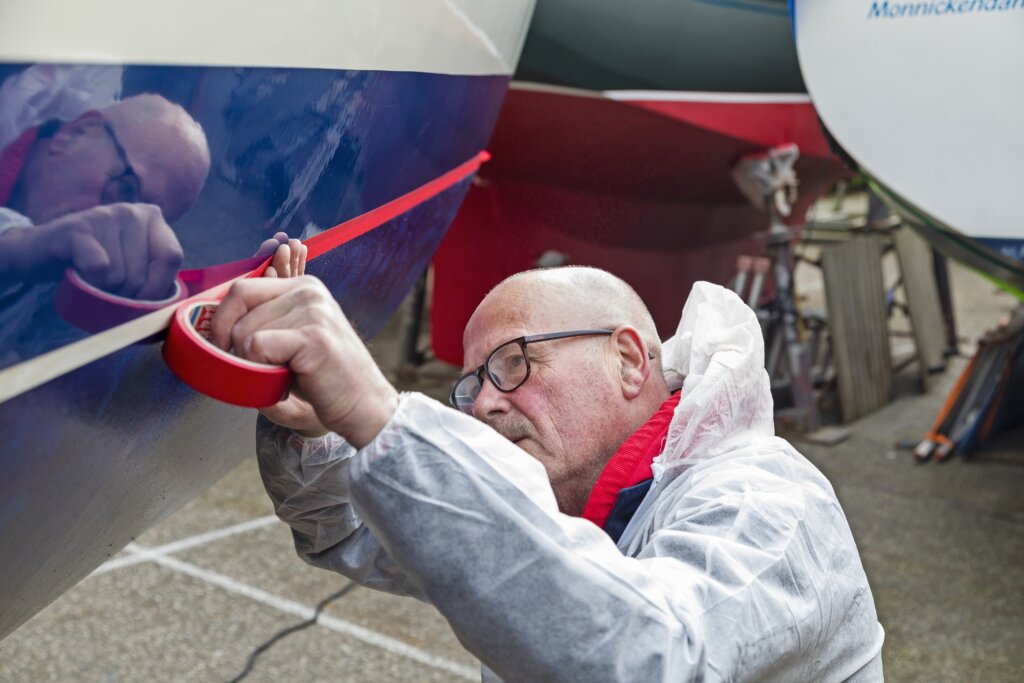

A huge job
On the morning of application, Wouter and Walda were fortunate that the wind had abated, reducing the risk of contamination. They found the paint thick enough that it didn’t splatter when rolled carefully, allowing them to work at a steady pace. Following the application of the initial coat, it became apparent that there wasn’t complete coverage. The lighter tiecoat could still be seen, albeit only faintly. Once the initial coat had been applied, Wouter removed the masking tape before the paint had dried. When the surface was dry, he masked the waterline again in preparation for the next coat. After the second coat had been applied a day later, the hull was a uniform dark blue. The paint dried fast, quickly becoming touch-dry. Wouter then removed the masking tape for the final time.
After the second coat had been applied a day later, the hull was a uniform dark blue. The paint dried fast, quickly becoming touch-dry. Wouter then removed the masking tape for the final time. He was pleased with the result of his efforts. “It was a significant undertaking, but in hindsight, I’m not disappointed,” he said, still wearing the active carbon facemask. “The advantage is that for at least two years we don’t have to do any more painting.” However, during the season, it is necessary to remove soft fouling with a sponge or microfibre cloth.
A day later, Freya was afloat again and Wouter and Walda were preparing for the upcoming sailing season. Prior to launching the vessel, Wouter had taken the precaution of protecting the areas where the lifting straps would touch the hull with a sheet of plastic to prevent any damage to the B-Free Explore. “When the boat is lifted out of the water in autumn,” he said, “we’ll assess the durability of the B-Free Explore.”
We’ll provide an update of their findings on Zeilen.nl in November.

Costs
What does it cost to switch to the B-Free Explore system? For the Friendship 28, Freya, this is the final breakdown:
Materials
B-Free Conversion Coat € 125
B-Free Tiecoat € 125
B-Free Explore € 200
Application
Hoover and sander rental (1 week) € 384
Brushes, tape, protective equipment, overalls € 165
Total cost € 999 *
Cost per year for the Friendship 28 Freya: € 500,00
* Prices may vary and will depend on the size of the boat. While the initial cost may appear considerable, the B-Free Explore system is designed to last for two years without the need for additional applications. Consequently, the annual costs can be cut in half. On freshwater, re-application times may be even further extended. Please note, that to prevent fouling, it’s essential to clean the hull periodically using a sponge or soft microfibre cloth.
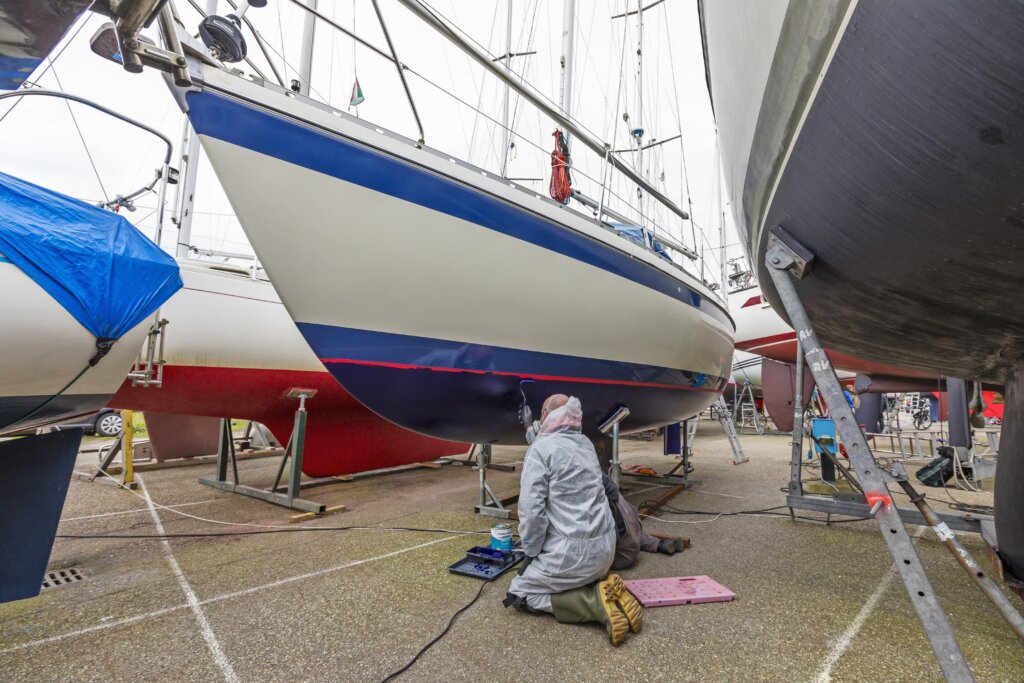
Silicone contamination
If you’re working with paint that contains silicone, it’s important to be aware of the potential for silicone contamination. Small splashes, from a roller for instance, onto areas of the boat where no silicone paint has been applied, can create issues when attempting to work on those parts at a later stage. Other paint systems will not adhere well, and silicone residue may cause defects in the finish.
It’s important to exercise caution when working with silicone paint to avoid contamination of surrounding areas.
- Carefully mask off parts that are in close proximity to the area to be painted.
- The masking tape should be removed immediately after the paint has been applied.
- All waste must be disposed of in a separate bin bag, along with any rollers, brushes and gloves that have come into contact with the silicone paint.
If you’ve inadvertently introduced silicone contamination into an area, good silicone removers are widely available on the market.

This article was created in collaboration with International Paint. Further information about the B-Free Explore fouling control system can be found at International-yachtpaint.com/en/b-free-2023.
If you have any queries regarding the B-Free Explore system and its use or application, please don’t hesitate to contact the helpdesk on 0800-022 6555 or via iyp.nederland@akzonobel.com.
Last modified: 13 November 2024
